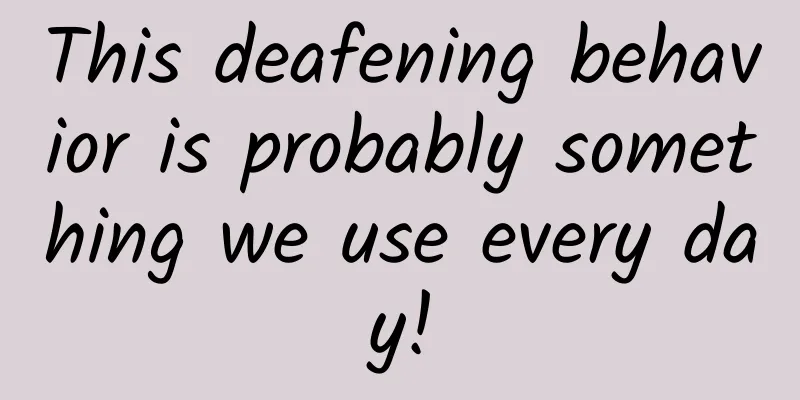This deafening behavior is probably something we use every day!

|
When riding the subway, put on headphones and watch TV series; When running and exercising, put on headphones and listen to dynamic music; Lying in bed, putting on headphones and watching videos; … Put on your headphones and you own the world Headphones are the standard equipment for contemporary people! However, wearing headphones for a long time and exposing your ears to noise can cause irreversible damage to the ears, and in severe cases can lead to deafness. Recently, a Weibo post about "A 16-year-old boy became deaf due to wearing headphones for a long time to play games" became a hot search, attracting more than 70 million people to watch. In fact, this kind of news often appears in newspapers. According to data released by the World Health Organization in 2019, about 1.1 billion young people (aged 12 to 35) worldwide are at risk of hearing loss due to improper use of audio devices such as headphones. Data from the World Hearing Report also shows that one-fifth of people in the world have hearing loss, of which 430 million have moderate or higher hearing loss. So, why is wearing headphones for a long time so harmful? Let me tell you about it. Our ears are structured like this↓↓↓ When external sound waves enter the ear, they are first converted into vibrations by the periosteum, and then transmitted to the cochlea in the inner ear by the ossicles (malleus, incus and stapes). The hair cells in the cochlea then convert the vibrations into nerve signals and transmit them to the brain. Finally, the auditory center processes the nerve signals into sounds that we are familiar with. However, the cochlear hair cells are very fragile. Excessive volume can cause the cochlea and auditory ossicles to vibrate violently, directly damaging the hair cells. At the same time, excessive stimulation can also cause metabolic overload, damage the hair cells, and cause a large number of hair cells to die. The point is that the number of hair cells is limited. If one dies, there is one less, and it will never grow again! ! When the inner ear loses hair cells, it affects sound transmission and hearing becomes incomplete. Therefore, the damage to hearing caused by noise is irreversible! ! At the same time, noise-induced hearing loss is divided into acute and chronic: Acute injury: It is caused by sudden strong noise at close range, such as the scenes in the TV series about the war of resistance against Japanese aggression, where people are deafened by huge explosions of grenades and mines. Chronic damage: caused by long-term exposure to low-intensity noise, such as auditory fatigue caused by wearing headphones for a long time. It would be foolish to talk about harm without considering the volume. So, how loud is the volume to damage hearing? ★Medical data show★ When the volume exceeds 85 decibels, more than 8 hours can cause auditory fatigue; When the volume reaches above 110 decibels, it may cause irreversible hearing damage. The volume output of the headphones we usually use is generally around 84 decibels, and some high-frequency ranges can reach 120 decibels. However, many people like to wear headphones on noisy subways and buses. In order to hear the sound in the headphones clearly, they will unconsciously turn up the volume, which greatly exceeds the tolerance of the ears. Maybe you will say that it is okay to turn down the volume of the headphones? Although it is theoretically possible, wearing headphones for a long time may also cause other ear diseases: There is a certain amount of pressure on the external auditory canal, which leads to local ischemia and itching. Many people will then pick their ears involuntarily, which may damage the ear canal barrier. Over time, this will increase the risk of infection. The ear canal environment will become humid and hot, creating conditions for the reproduction of bacteria and fungi. If the skin barrier is broken, it may lead to external otitis. "60-60" principle: The World Health Organization recommends that the volume of headphones should not exceed 60% of the maximum volume, and it is best to adjust it to a lower level; ≤60 minutes a day is relatively safe, and intermittent listening is appropriate to allow the ears to get sufficient rest. Try not to wear headphones in a very noisy environment. Don’t wear headphones when sleeping: When you sleep, the ears wearing headphones will be pressed on the pillow, which will increase the stimulation to the eardrum; if you fall asleep without taking off the headphones, the time you wear headphones will be prolonged. If there is a rustling sound in the earphones or only one side can hear sound, it is not suitable to be used anymore, otherwise it may affect the hearing balance for a long time. If you must wear headphones, it is recommended that you choose over-ear headphones, because in-ear headphones have a small sound contact area, exert a higher pressure inside the cochlea, and cause greater stimulation. At this point, some people may not agree, but I still urge everyone to pay attention to hearing problems, otherwise you may become a "little deaf person" at a young age! ! |
>>: One man's plan to resurrect the animals we can't save
Recommend
How to quickly acquire users in a short period of time at zero cost?
This time I want to share how product operations ...
The stove ignited the quilt, 13 people were trapped! How to prevent safety when heating in winter?
Evening of December 27 A fire broke out in a resi...
The first new energy family car in the Year of the Snake, Trumpchi E8 PRO+ is priced at 209,800 yuan for a limited time.
Chang'an is in a prosperous era and happiness...
Hong Raiders Value Season Ranch Ranch A Intensive Training Camp
Hong Raiders Value Season Ranch Ranch A Intensive...
Going back to the past and heading to the future, why are black holes time machines? Is time travel really possible?
Black holes are time machines, but they have hidd...
Is information flow too expensive? Tell you how to create the effect of 5 million with 500,000!
With the expansion of social networks , the incre...
The color of salt is so attractive! Unlock the secrets of China's most beautiful salt lakes
Say goodbye to the crowded popular attractions. T...
Achieved for the first time! Congratulations to Chinese scientists
Chinese scientists develop "miniaturized thr...
The chicken mushroom, known as the "king of mushrooms", is unforgettable to Xu Xiake and Li Shizhen!
Termitomyces albuminosus is a fungus that lives i...
Uncovering the gray industry chain of short-lived mobile games that suck money like crazy
[[129846]] With the development of mobile Interne...
Zhu Kezhen: The weather is always changing, but your heart remains unchanged
Liu Qian and Zhang Yingxian Editor's Note Rec...
How effective is paid promotion of mobile apps? With all the chaos going on, who can you trust?
We spend money on promotion for the sake of resul...
Qian Xuesen named VR "Spiritual Realm", the romance of Chinese culture is all in it
In April 1996, at the Beijing Military Museum, a ...
APP operation indicators and promotion and marketing suggestions!
How to do a good job in App operation and promoti...
Interpreting ASP.NET 5 & MVC6 Series (4): Core Technology and Environment Configuration
asp.net 5 is the next generation of asp.net. This...









